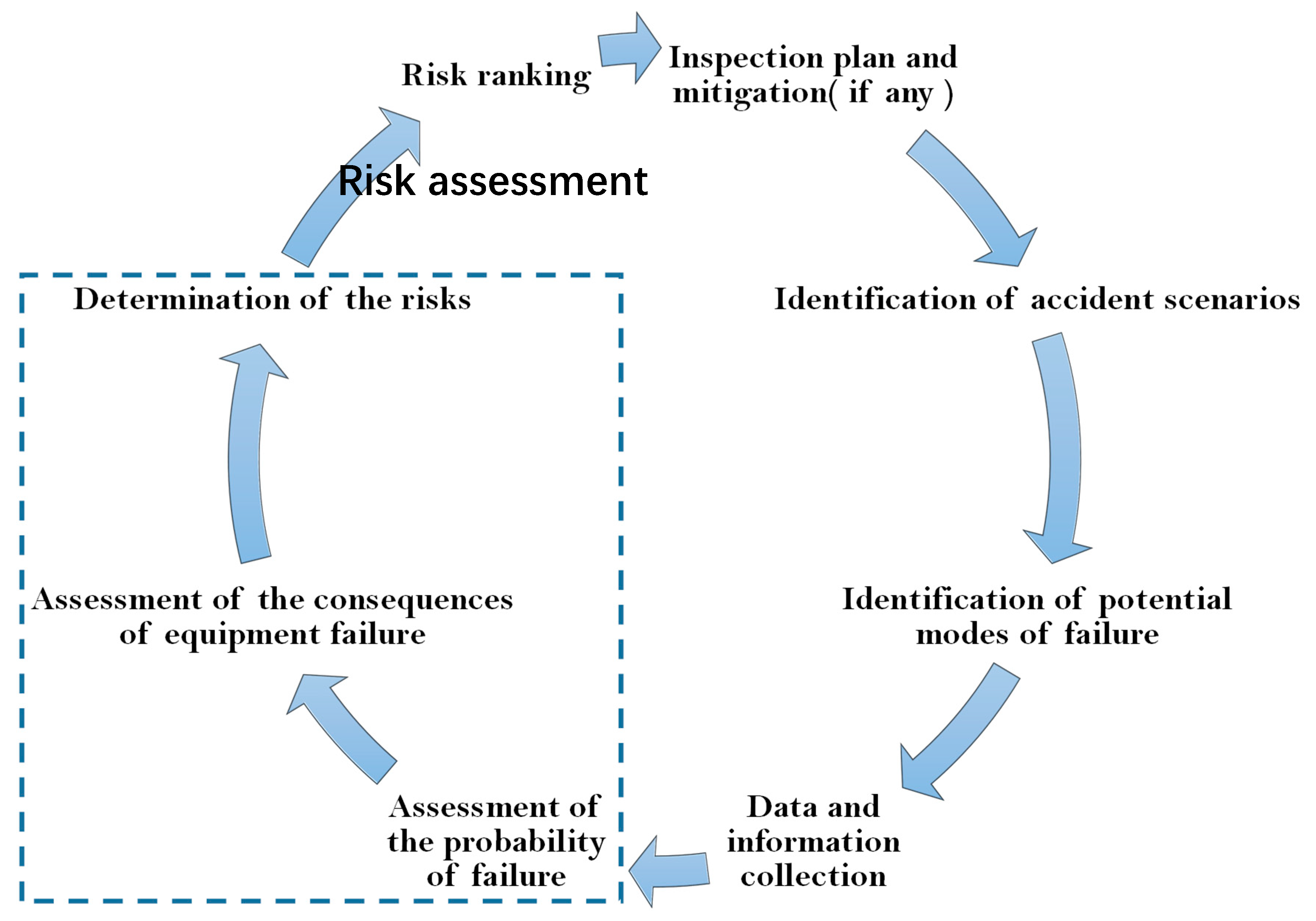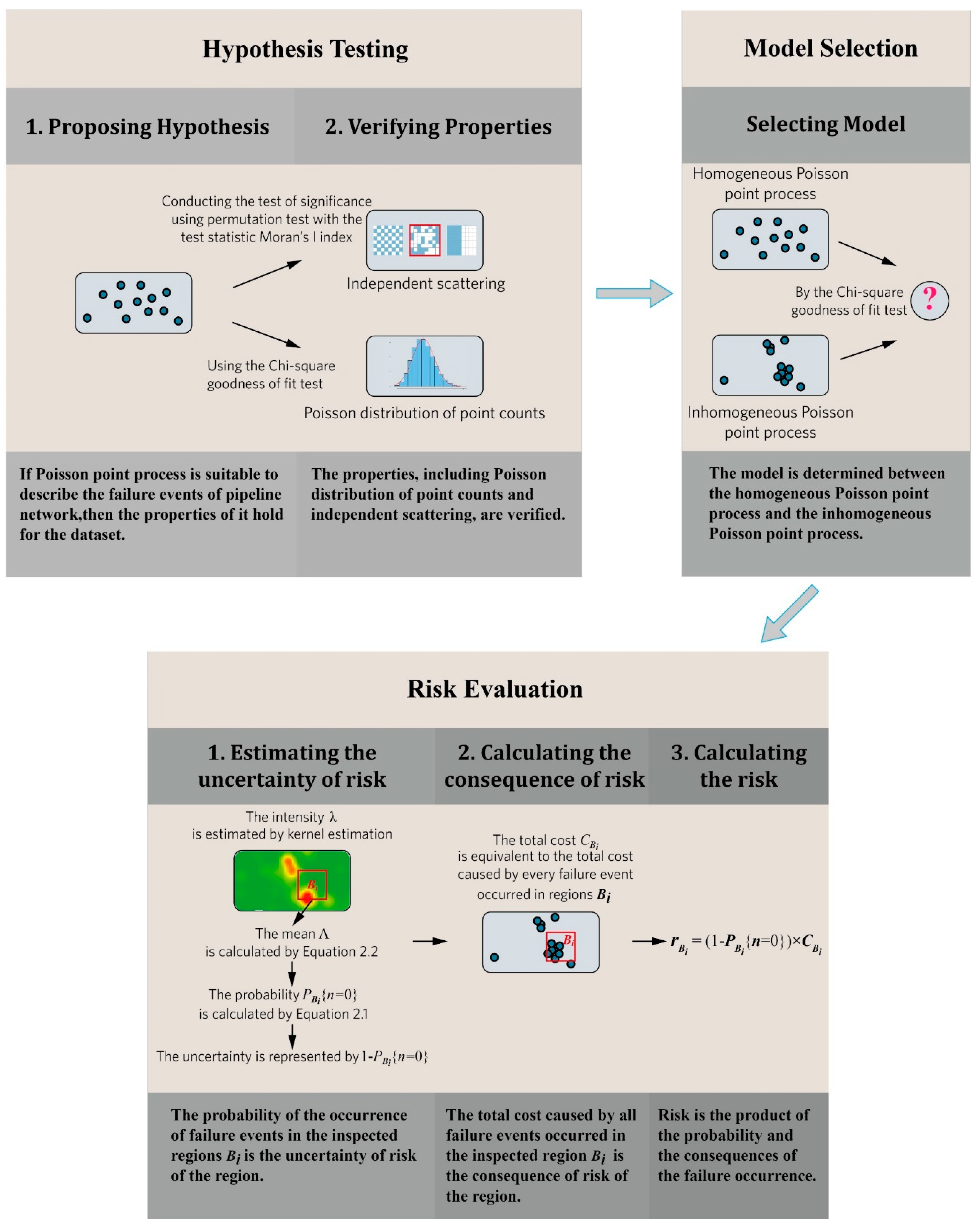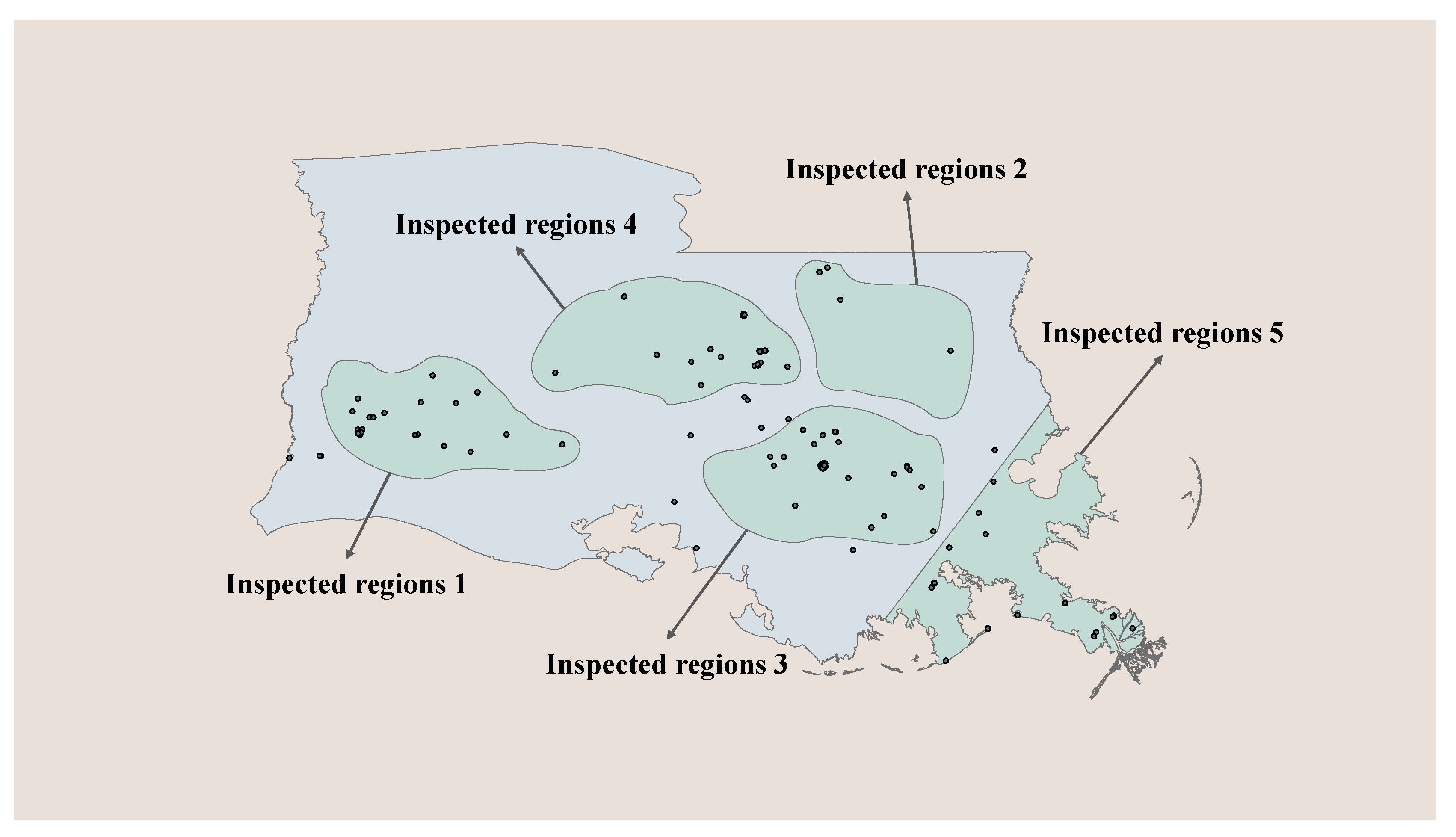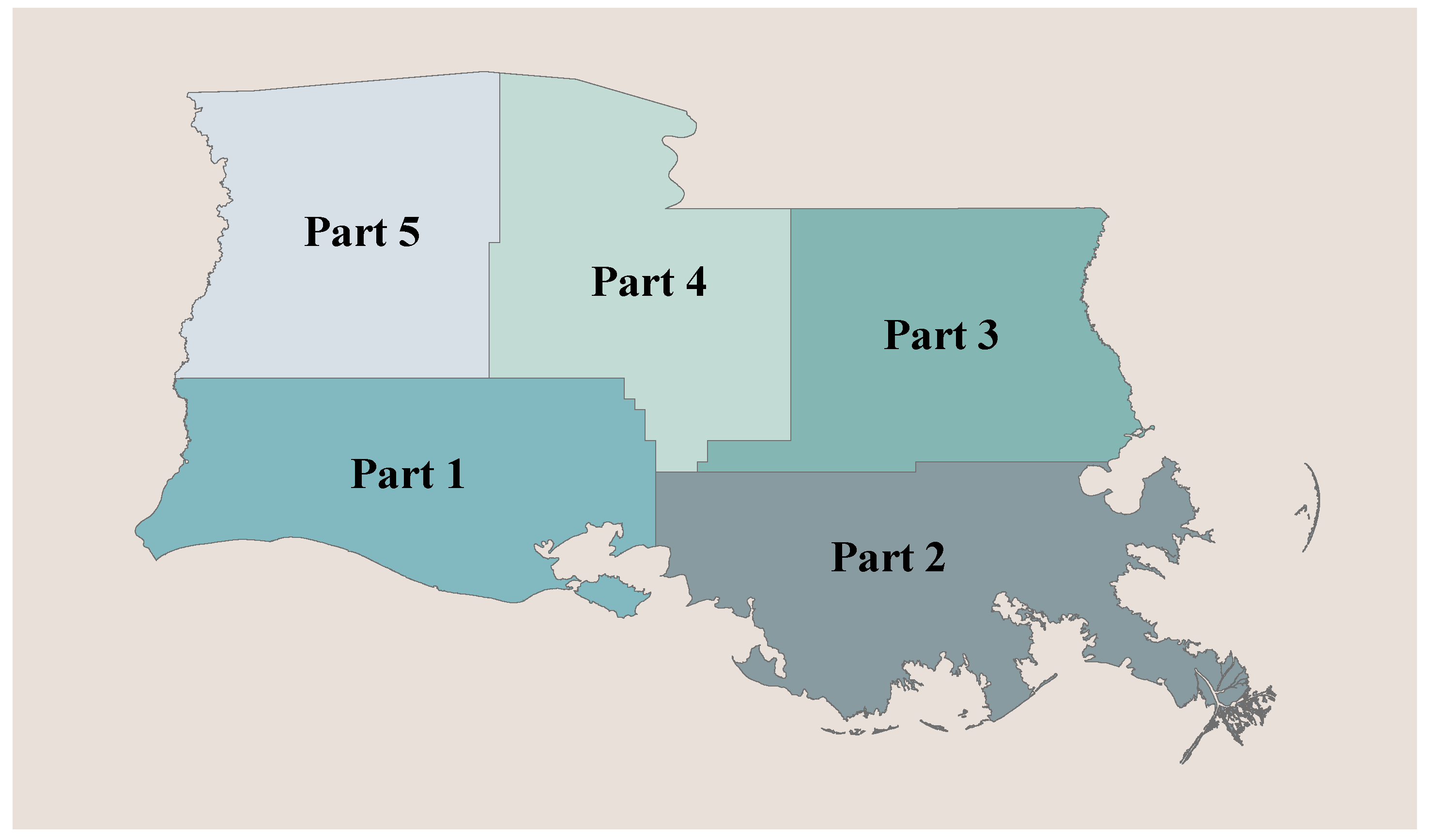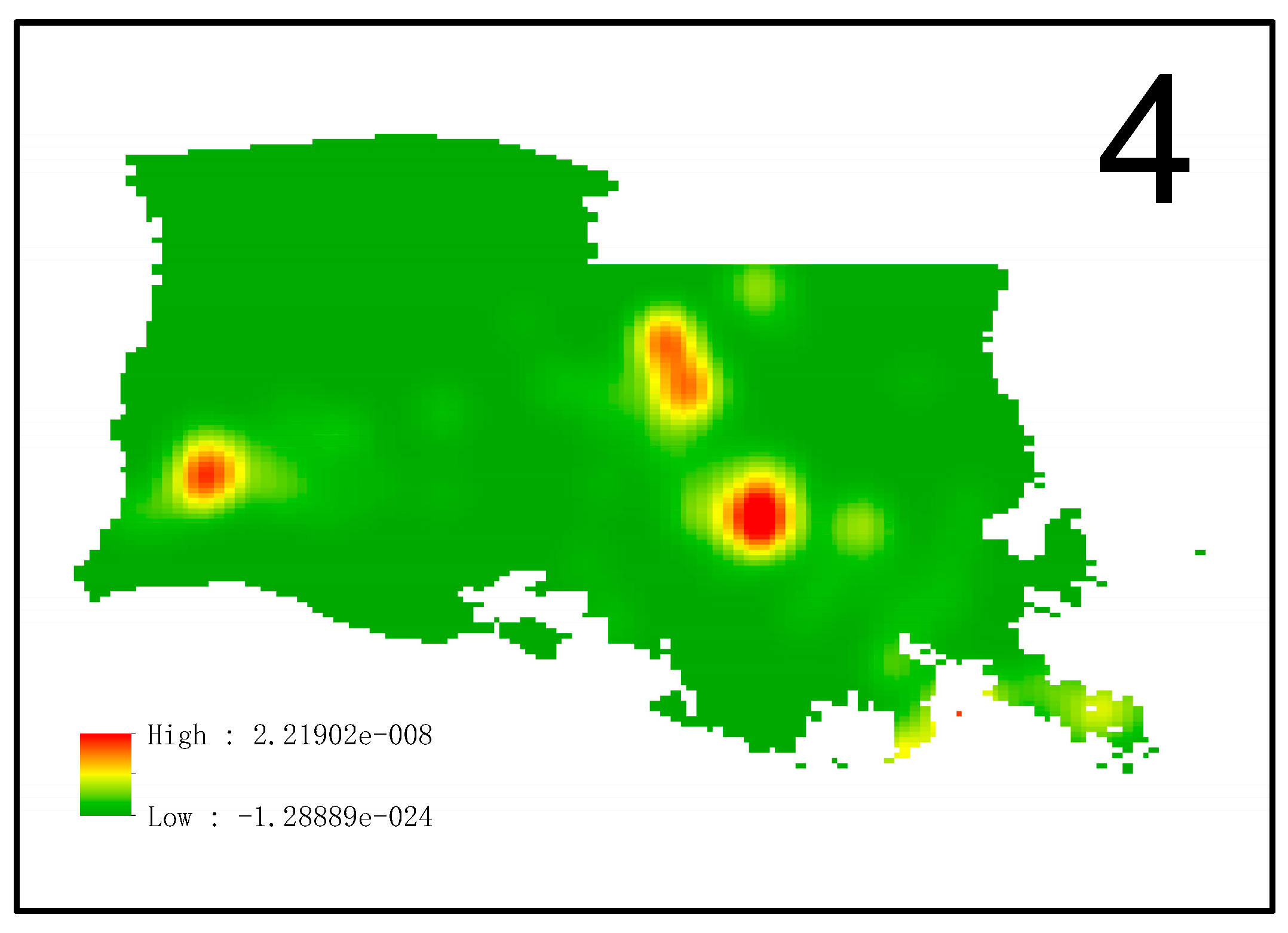The proposed approach includes three procedures: hypothesis testing, the model selection, and risk evaluation, which are shown in
Figure 3. First, the reported locations of failure events in the observed window are processed using the GIS software. The aim of hypothesis testing was to validate the availability of the proposed approach. In this procedure, a hypothesis was proposed, which stated that the Poisson point process was a suitable model for the dataset of pipeline failure events. This hypothesis was tested based on the processed data. In the procedure of model selection, our approach was to determine the inhomogeneous Poisson point process or the homogeneous process to be used as the model for modeling the dataset. After that, the risks of the different inspected regions were assessed. The intensity of the chosen model was first estimated, which is the foundation for estimating the uncertainty of risk in different inspected regions. Then the consequence of risk in different inspected regions was calculated.
3.1. Hypothesis Testing
Based on the information in prior research [
30], Poisson point process can be used to describe the failure events of a pipeline network. Therefore, the null hypothesis in our approach was stated: if the Poisson point process is suitable to describe the failure events of the pipeline network, then its properties should not be violated in the application of the proposed approach. Therefore, two properties were tested in our approach.
The first test was to verify the property of the Poisson distribution of point counts through the application of a chi-square goodness of fit test. In our approach, this hypothesis was suggested to determine whether the number of failure events that occurred in the observed window follows a Poisson distribution. The key reason for this suggestion is that any part of the observed window may not have sufficient failure event samples for the application of most statistical tests. Therefore, the observation of failure events in the observation window is chosen to test the property of the Poisson distribution of point counts with the consideration of the feasibility of tests.
Before the conduction of the first test, period
must be determined, and should be considered with the inspected interval time. After that, the frequency of failure occurrence (henceforth referred to as the sample data) in the given period
is obtained based on the records of the failure events. This process is illustrated in
Figure 4. Then, the chi-square goodness of fit test can be implemented.
In the chi-square goodness of fit test, the null and alternative hypotheses are as follows:
H0. The quantity of pipeline failure events in region and a given period follows a Poisson distribution.
H1. The quantity of pipeline failure events in region and a given period does not follow a Poisson distribution.
Under the null hypothesis, the mean
was estimated from the sample data by referring to Equation (3). Next, the theoretical frequency
for each type of occurrence (
) was obtained by multiplying the estimated Poisson probability
with the size of the sample data
. The estimated Poisson probability
was determined according to the Poisson distribution with the estimated
. Finally, the
test statistic was calculated via Equation (4) to determine whether to reject
H0.
In testing the second hypothesis, the property of independent scattering was verified. The test is essentially a test of significance, which combines a permutation test with the test statistic Moran’s
I index [
36,
37]. Moran’s
I index is a commonly used spatial statistic [
38], which describes autocorrelation in the spatial dimension by measuring the degree to which the number of failure events in different spatial regions of the pipeline network is similar to each other. In our approach, two groups of numbers of failure events in different spatial regions of the pipeline network were suggested for this test respectively. The first group of numbers was
,…,
, counted from the inspected regions of the pipeline network (as shown in
Figure 5). The second group features the counts of all districts obtained by the division of the observed window (shown in
Figure 6). Both of these tests could determine whether the property of independent scattering was retained. If the property were held, we could conclude that the numbers of failure events in different spatial regions are independent Poisson random variables with the conclusions from testing the first hypothesis.
In the first step of testing the second hypothesis, the initial Moran’s
I was obtained by Equation (5) based on the counts of every group. In the equation,
is the element of the spatial weight matrix whose dimensions are
(
is the amount of regions). The spatial weight matrix reflects the level of spatial proximity of two different regions by defining the element
. In our approach, the element
is obtained based on quantity
and the threshold distance. If quantity
is larger than the threshold distance, the element
is set to 0. If not, element
is equal to quantity
. Quantity
is calculated by the centroid distance between regions
i and
j. Generally, the values of Moran’s
I range from −1 to +1. Values larger than
indicate positive spatial autocorrelation, and a Moran’s
I of less than
indicates negative spatial autocorrelation.
In the second step, a permutation test was conducted. It is reasonable to believe that the counts (such as ,…, ) were randomly assigned to different regions based on the null hypothesis: the counts in different regions are spatially independent (the alternative hypothesis is that the counts in different regions are spatially dependent). Therefore, we rearranged the counts for all the different regions (such as ,…, ) and recalculated the Moran’s I value. Then, the distribution of the test statistic Moran’s I could be obtained. To calculate the p-value for the permutation test, the number of Moran’s I that was or more extreme than the initial Moran’s I was counted. Then, divided the number by the total number of Moran’s I that had been calculated. The quotient of the division was the p-value. Finally, we decided to accept the null or alternative hypothesis according to the level of significance for the test.
3.2. Model Selection
After the hypothesis testing, we could conclude that the Poisson point process was able to describe the failure events of the pipeline network. Therefore, the objective of model selection was to determine which type of Poisson point process was a suitable one. In our approach, to achieve the objective, we proposed a test that reviewed whether the intensity of the failure event is spatially variable.
In this test, the null hypothesis is stated as follows: If the homogeneous Poisson point process is a suitable model, then the intensity is not spatially variable. However, the alternative hypothesis provides no further information for the selection of models because inhomogeneous intensity or the violation of the properties of the Poisson point process can both cause a departure from the null hypothesis. Fortunately, we could eliminate the cause behind the violation of these properties according to the test results obtained during hypothesis testing. Therefore, the alternative hypothesis could be described as follows: if the inhomogeneous Poisson point process is a suitable model, then the intensity is spatially variable.
Before the test, the observation window
is divided into different parts
,…,
(as shown in
Figure 6), all of which must have an equal area
. Here, the counts
,…,
are independent Poisson random variables distributed with the mean
based on the null hypothesis and the assumptions above. Therefore, testing the goodness of fit of the counts to the Poisson distribution with the mean
can help us to determine whether or not to reject the null hypotheses.
